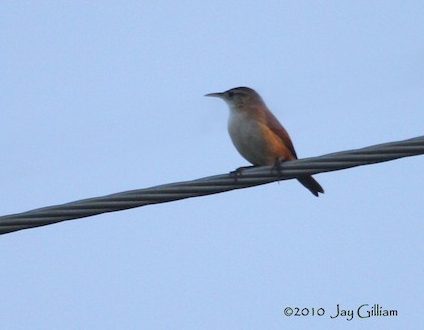Birdfinding.info ⇒ The St. Vincent endemic form of House Wren is fairly common across much of the island and can be found at most of the frequently visited sites, including the Vermont Nature Trail.
“St. Vincent Wren”
Troglodytes aedon musicus
Endemic to St. Vincent, where it occurs in forests, woodlands, parks, and gardens.
Identification
A small, brown-and-buffy wren. The only wren known from St. Vincent.
The underparts are mostly pale buffy, tinged rusty on the sides, flanks, lower belly, and undertail coverts.
The upperparts are warm-brown with darker brown barring on the wings and tail. Usually shows a post-ocular stripe.
The bill is mostly yellowish, somewhat darker on the upper mandible.

“St. Vincent Wren,” T. a. musicus. (Vermont Nature Trail, St. Vincent; April 12, 2017.) © Frantz Delcroix

“St. Vincent Wren,” T. a. musicus. (Kingstown, St. Vincent; November 12, 2010.) © Jay Gilliam

“St. Vincent Wren,” T. a. musicus. (Vermont Nature Trail, St. Vincent; June 14, 2017.) © Josep del Hoyo
Notes
Monotypic form, one of ten or so distinct forms of House Wren—or Southern House Wren, when differentiated—some of which may be best regarded as separate species.
References
Brewer, D., and B.K. MacKay. 2001. Wrens, Dippers, and Thrashers. Yale University Press. New Haven.
eBird. 2019. eBird: An online database of bird distribution and abundance. Cornell Lab of Ornithology, Ithaca, N.Y. http://www.ebird.org. (Accessed December 8, 2019.)
Kroodsma, D., D. Brewer, and G.M. Kirwan. 2019. House Wren (Troglodytes aedon). In Handbook of the Birds of the World Alive (J. del Hoyo, A. Elliott, J. Sargatal, D.A. Christie, and E. de Juana, eds.). Lynx Edicions, Barcelona. https://www.hbw.com/node/58151. (Accessed December 8, 2019.)
Raffaele, H., J. Wiley, O. Garrido, A. Keith, and J. Raffaele. 1998. A Guide to the Birds of the West Indies. Princeton University Press, Princeton, N.J.
